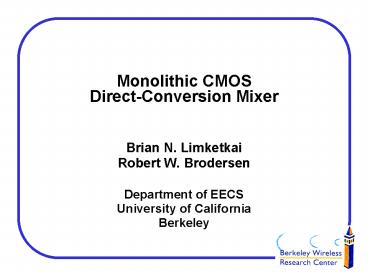Monolithic CMOS DirectConversion Mixer
1 / 9
Title: Monolithic CMOS DirectConversion Mixer
1
Monolithic CMOSDirect-Conversion Mixer
- Brian N. Limketkai
- Robert W. Brodersen
- Department of EECS
- University of California
- Berkeley
2
Direct-Conversion Receiver Architecture
cos 2pfRFt
PN Code
RF input (fRF)
A/D
I (800 kS/s)
A/D
Q (800 kS/s)
BB Filter
Correlator
sin 2pfRFt
- Things to worry about
- noise
- power consumption
- conversion gain
- linearity
- port isolation
- Mixer Design
- choose passive or active
- relaxed requirements allow for simpler designs
and lower power consumption - make compromises to simplify design of LNA and LO
3
The Contenders
- Passive Mixers
- Pros
- high linearity
- low power
- Cons
- conversion loss
- LO to RF feed-through
- may need LO buffer to drive switches
- Active Mixers
- Pros
- conversion gain
- good isolation between ports
- may add VGA capabilities
- Cons
- consumes power
- may need LO buffer
- may need common-mode feedback
4
Passive CMOS Switching Mixer
- gain is at RF (on chip inductors are not very
good but may be adequate) - input-referred noise from mixing core is reduced
by additional gain - relaxed requirements can tolerate more noise,
thus smaller switches can be used - no flicker noise from switches
- small switches do not require LO buffer
- conversion loss may be dependent on LO waveform
5
How Bad is the Conversion Loss?
Conversion loss of the passive CMOS switching
mixer depends on the LO waveform and average
conductance
approximate as conversion gain is
equivalent model of the mixer is
For sinusoidal LO, conversion gain is For
square waves, conversion gain is
6
Active Gilbert Quad
- gain is achieved at baseband so loading
capacitance is not critical - inductors not needed
- flicker noise from switching pair can be
significant - could add RF gain stage before the active mixer
- reduces input-referred noise from mixer
- reduces gain requirement of mixer
- better port isolation than passive implementation
- consumes very little power
7
Variable Gain Capabilities
- common-mode feedback not needed
- common-mode will vary as gain varies
- feedback in biasing keeps resistance constant
over process corners
- common-mode feedback needed
- common-mode invariant as gain varies
- gain may vary over process corners
8
Improving Linearity in the Gilbert Quad
- For the input differential pair
- increase Vdsat to improve linearity and noise
- decrease channel length
- For the MOSFET loads
- increase channel length
- decrease width (to place device deeper into
triode region)
9
Future Work
- noise comparison between active and passive
mixers - linearity comparison
- check matching sensitivity
- layout































